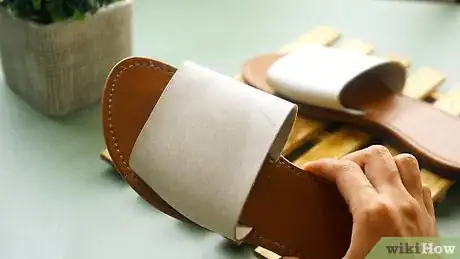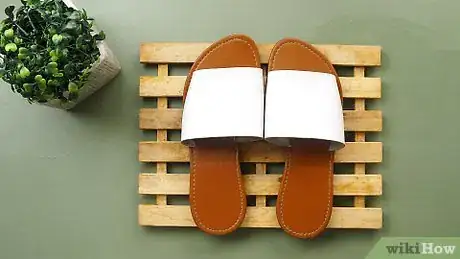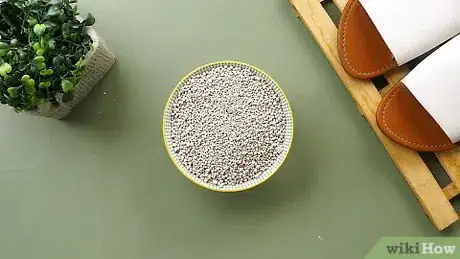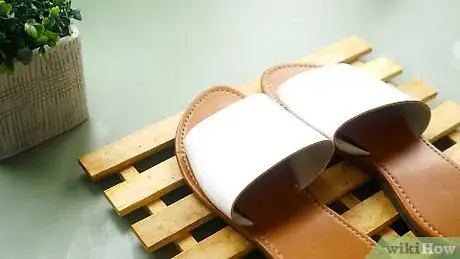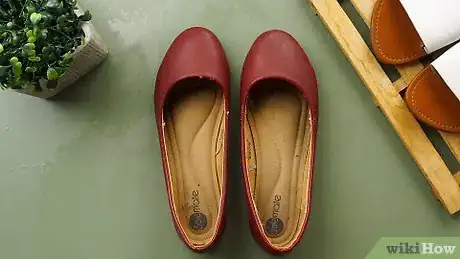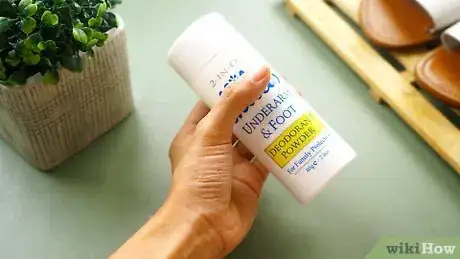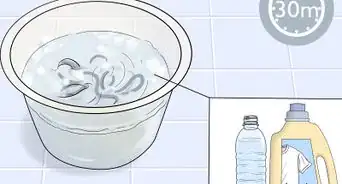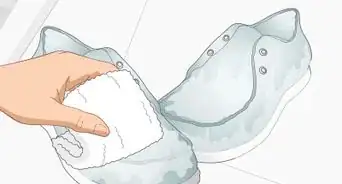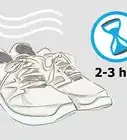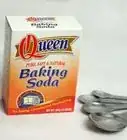This article was co-authored by Susan Stocker. Susan Stocker runs and owns Susan’s Green Cleaning, the #1 Green Cleaning Company in Seattle. She is well known in the region for outstanding customer service protocols — winning the 2017 Better Business Torch Award for Ethics & Integrity —and her energetic support of green cleaning practices.
wikiHow marks an article as reader-approved once it receives enough positive feedback. In this case, 80% of readers who voted found the article helpful, earning it our reader-approved status.
This article has been viewed 198,661 times.
Leather sandals are comfortable, stylish, and tend be more durable than sandals made of most other materials. On the down side, they also tend to show dirt, water stains and other marks that cause them to lose their fresh appearance. Since leather cannot be thrown into the laundry or submerged in water, you might wonder how to clean your sandals. Identify what needs to be done and the materials you'll need to do it, and you'll have clean sandals in no time.
Steps
Leather Cleaning Tips
-
1Pinpoint your issue. Leather stains and discolorations are caused by a lot of different factors, so you need to figure out what is ailing your shoes before you can fix it.
- Leather sandals often show spots or discoloration from contact with water, which might look unattractive but isn't "dirty" per se. One quick remedy involves a 1:1 ratio of white vinegar and water, which you can light blot on the discolored areas-- this also works on salt stains on leather boots in the winter.[1] Be sure not to saturate the leather.
- Dirty sandals carry everything from streaks of mud to deeper stains of oil, wine, or other liquids. You will need to consider the type of stain and desired results to clean leather sandals properly. You may also just want to polish or buff out scratches, scuffs, or other marks.
- If you only have a small stain, dish soap or liquid hand soap will work fine. Avoid bar soap, which has a higher pH level than leather,[2] and can cause it to dry out. For larger or stubborn stains, try leather conditioner, available at your local big box store or shoe store, or online at most big retailers.[3]
-
2Rub away any dirt and other solids. You should always remove any dry debris from your shoes before applying any type of cleanser or moisturizer to the leather. Otherwise, you'll create a muddy mess that will be harder to remove.
- Use a dry, soft cloth or soft-bristled brush (an old toothbrush will work well) and a very gentle hand. Keep in mind that soft, supple leather can be easily scratched, so if you are wiping off dirt and you use too much force you might actually cause a permanent mark on your shoe.
Advertisement -
3Wash the sandals. Begin by moistening a clean, soft cloth, then apply a small amount of soap or leather conditioner to the cloth.
- Now, gently rub the dirty spots. You should try to use a gentle, even motion, and create a lather.
-
4Wipe the lather and conditioner away. Using another clean, slightly damp cloth, use a circular motion to remove the product from the leather. Be sure you remove it all.
- Although you want to reduce the level of moisture that you're introducing into the sandal, it's important to wipe away any cleaning products from clean sandals. A damp cloth is the best way to do this. If one cloth is not enough to remove the product, use another.
-
5Dry your sandals. Before you wear them again, you need to let them dry thoroughly. Otherwise you may get more dust or debris on the wet spots and cause a stain.
- Natural light and sun are the best way to dry leather footwear, but don't place them in direct sunlight. The sun can break down the leather and cause cracking.[4]
- Don't try to dry your sandals by rubbing them, and don't wear the sandals until they're completely dry.
Odor Elimination
-
1Apply baking soda dry sandals to get rid of smelly odors. Baking soda naturally absorbs odors, is very affordable, and is available at any grocery store or big box store.[5]
- Place shoe inside a large zip top plastic bag. Sprinkle the inside of the shoe liberally with baking soda. Seal the bag and leave it overnight.
- You can also try adding a drop or two of essential oils, like lavender or sweet orange oil, to add a pleasant scent. Put the oil directly on the baking soda before applying to the shoes, not on the shoes themselves. Don't add more than a few drops, as the oil can cause even more problems by sticking to the shoes and attracting dirt.
- Be sure to wipe out all of the powder before putting the shoes on again.[6]
-
2Try cat litter. If baking powder alone doesn't do the trick, you can try using cat litter to absorb the remaining smells.[7]
- Get a pair of old pantyhose. If you don't have any handy, you can use the little disposable socks available at most shoe stores for customers trying on new shoes.
- Fill the foot end of the pantyhose with a scoop of cat litter.[8] If you don't have a cat, ask a friend who does if you can have a bit of litter. You will only need about two cups total, so it's really not worth buying a whole bag.
- Tie off the pantyhose and stuff it inside the shoe, again leaving it overnight.[9] The litter is formulated to absorb smells and many brands will also leave behind a nice aroma.
-
3Replace your insoles. The smell inside of leather shoes is often contained in the insole, where dirt and sweat get trapped and bacteria cause a stink. Taking out the insoles is often the only way to salvage the shoes.
- If your insoles are removable, replace them with fresh ones. You can buy insoles based on your shoe size at any big box store or online. Look for a brand that gets good customer reviews and that is specially designed for open shoes.
- If your shoes do not have removable insoles, you might want to take them to a shoe repair expert. Often a cobbler can cut out the insoles and fashion new ones. This is probably only worth trying if your shoes are expensive and/or no longer available for purchase, since a cobbler will charge quite a bit to replace the insoles in your shoes.
-
4Kill the germs. Shoe odor is caused by bacteria feeding on the dirt and sweat inside your shoes. If you want to eliminate the smell, you have to eliminate the bacteria.
- At the end of every day, spray the inside of your shoe with a commercial shoe deodorizer or disinfectant that is specially formulated to kill bacteria.[10] Look for a shoe spray that is marketed for use in athletic shoes; these are the strongest available since athletic shoes tend to be the smelliest.
- You can also try making your own natural disinfectant spray from water, tea tree oil, and vinegar, and using this to spray your shoes instead.
- Be sure you leave your shoes to dry thoroughly before wearing them again. You can place them outdoors on a warm, dry day, but be sure to place them out of direct sunlight. You can also place them atop the dryer or in another warm spot inside.
Long-Term Care Tips
-
1Treat new sandals with a leather preservative. When you first purchase leather sandals or other footwear, you can apply spray to the outer leather parts to make them water-resistant and stain-resistant.
- To prevent the spray from getting in the sandal footbed, stuff the sandal with crumpled newspaper before spraying.
-
2Keep your sandals dry. Leather discolors if it becomes wet, and saturating your sandals can also lead to odor problems.
- Choose synthetic materials for your rainy-day footwear, such as rainboots or rubber flip-flops. If you want to wear your fancy leather sandals for a special occasion, stash them in your purse or backpack and change when you're inside where it is dry.
- Be sure to let your sandals air out completely if they do happen to become wet. Place them in a warm, sunny, and dry place until dry. Don't leave them in direct sunlight, though, as that can dry out the leather and lead to cracking.[11] A window is a good location.
-
3Don't allow dirt to get in your shoes. During hot weather, dirt, dust, or sand often gets trapped inside sandals. When the dirt combines with your natural foot sweat, it can create a very stinky situation. This can be particularly noxious in humid climates, where moisture in the air contributes to the wet, warm environment in your shoes. This is why people who don't typically have smelly feet might suddenly develop foot odor in the summertime.
- Wear closed shoes like tennis shoes if you will be walking through sand or dirt, like when you go to a playground or beach. If you want to feel the sand in your toes, take your shoes off, and don’t put them back on until you can wash your feet properly.
- Be consistent in keeping dirt out of your shoes. It only takes one time for dirt to get into your shoes and create a stink problem, especially if your shoes have a fabric footbed that is hard to clean.
-
4Practice good foot hygiene. This might seem like a no brainer, but sometimes stinky shoes are caused by stinky feet, and the only way to address the smell is to take better care of the feet that go in the shoes!
- Clean your feet with soap and water every day when you get home from school or work, and again before bed at night.
- Apply a daily foot powder, which will help to absorb odors and reduce sweatiness. You can also try a foot antiperspirant, which can actually help to prevent sweatiness in the first place. To find a good product, try doing an internet search and look for a product with high customer reviews.
Expert Q&A
Did you know you can get expert answers for this article?
Unlock expert answers by supporting wikiHow
-
QuestionHow do I stop my sandals from smelling?
 Susan StockerSusan Stocker runs and owns Susan’s Green Cleaning, the #1 Green Cleaning Company in Seattle. She is well known in the region for outstanding customer service protocols — winning the 2017 Better Business Torch Award for Ethics & Integrity —and her energetic support of green cleaning practices.
Susan StockerSusan Stocker runs and owns Susan’s Green Cleaning, the #1 Green Cleaning Company in Seattle. She is well known in the region for outstanding customer service protocols — winning the 2017 Better Business Torch Award for Ethics & Integrity —and her energetic support of green cleaning practices.
Cleaning Professional
-
QuestionHow do I clean the inside soles?
 Community AnswerUse a damp towel to clean them.
Community AnswerUse a damp towel to clean them.
Warnings
- Never submerge leather footwear in water. Proper sandal care means reducing the risk of making your problem worse, and people often find that after spraying and rubbing their sandals for hours their stains have only gotten larger. Keep water use to a minimum and rub gently.⧼thumbs_response⧽
- Some types of finished leather and suede leather are very difficult to clean at home. If you've spent a lot of money on your footwear and you want clean sandals that you can wear for years and that will keep their fresh appearance, it might be best to consult a professional.⧼thumbs_response⧽
Things You'll Need
- Dirty sandals
- Two dry cloths
- Soap or leather conditioner
- Water
References
- ↑ http://jezebel.com/winter-is-hard-on-your-shoes-heres-what-to-do-about-i-1450901787
- ↑ http://www.ncbi.nlm.nih.gov/pubmed/20487658
- ↑ Susan Stocker. Stain Removal Specialist. Expert Interview. 8 November 2019.
- ↑ http://www.esquire.com/style/advice/a6953/shoe-protection/
- ↑ Susan Stocker. Stain Removal Specialist. Expert Interview. 8 November 2019.
- ↑ http://blogs.zappos.com/blogs/how/2009/06/26/how-remove-odors-sandals
- ↑ http://blogs.zappos.com/blogs/how/2009/06/26/how-remove-odors-sandals
- ↑ http://blogs.zappos.com/blogs/how/2009/06/26/how-remove-odors-sandals
- ↑ http://blogs.zappos.com/blogs/how/2009/06/26/how-remove-odors-sandals
About This Article
To clean the exterior of your leather sandals, start by brushing off caked on dirt with a cloth or soft-bristle brush. Use a cloth that’s been dampened with water and a drop of dish soap to wipe them down, then use a cloth to wipe away the dish soap suds. To remove bad odors, sprinkle baking soda on the sole, seal your shoe in a bag, and leave it overnight. Then, shake out the baking soda and try again if there are still bad odors. For more advice, including how to use cat litter to get rid of bad odors in your sandals, keep reading!
